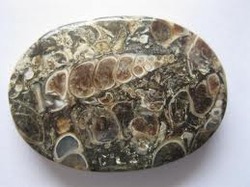Additional Details
Turritella Agate: Some 40-60 million years ago, an ancient saltwater sea covered what is now Wyoming. A snail of the Turritella species lived in its shallow waters. The shell of this snail is a small, long, tapering spire with numerous whorls. Today, fossil remains of the Turritella shell are found on the edges of Delaney Rim in south central Wyoming. The shell material has been completely replaced by agate and chalcedony. Agate and chalcedony are names given to a microscopically crystallized variety of quartz – the main component of which is silica. The Turritella agate may be tumbled and polished for weeks to give it. Turritella agate is from Wyoming. The proper name is Goniobasis, (pronounced gone-e-o-basis). The agatized fossil rough was misnamed many years ago, but the name turritella is still commonly used. The petrified agate or fossilized snails of turritella agate are colored ambered, golds or bluish in a gray black to dark brown matrix with the size of the fossil spiral snails up to 1 1/2" long. Size of the rough are from 1-15 pounds each. There may be some waste in this Eocene era (38-58 million years old) agate with areas not highly agatized. Slab turritella agate parallel with the flat lay of the snails to take advantage of the interesting shapes of these ancient gastropods that have been preserved by silica replacement. See turritella agate slabs for a slab sample. Turritella agate will make some very nice cabochons or tumble broken slabs or rough for unique tumbled stones.

